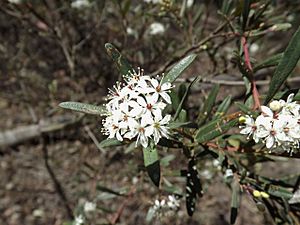Leionema obtusifolium facts for kids
Quick facts for kids Leionema obtusifolium |
|
|---|---|
 |
|
| Scientific classification | |
| Genus: |
Leionema
|
| Species: |
obtusifolium
|
Leionema obtusifolium is a special kind of small shrub. It has pretty yellow-white flowers that grow in bunches at the ends of its branches. You can only find this plant in Queensland, Australia.
Contents
What Does This Plant Look Like?
Leionema obtusifolium is a small shrub that usually grows up to 1 meter (about 3 feet) tall. It looks smooth and shiny. Its small branches are flat and have sharp corners. They also feel a bit bumpy.
The leaves of this plant are smooth and feel like paper. They are shaped like a narrow oval or a spoon. They are about 2.5 to 5 centimeters (1 to 2 inches) long and 3 to 6 millimeters (about 0.1 to 0.2 inches) wide. The leaves don't have a stalk; they attach directly to the stem. Their tips are rounded or blunt and have tiny scallops.
The flowers grow in groups of 10 to 20 at the end of the branches. These groups are called a "cyme" (say: SIGH-m). Each flower has a thin stalk about 4 to 8 millimeters long. The petals are yellowish-white and spread out. They are shaped like a narrow egg and are about 4 millimeters long. The parts that hold pollen (stamens) are about the same length as the petals. This plant usually blooms in spring.
How This Plant Got Its Name
This plant was first officially described in 1970 by a scientist named Paul G. Wilson. He first named it Phebalium obtusifolium. Later, in 1998, Paul G. Wilson decided to change its name to Leionema obtusifolium. This new name was shared in a science journal called Nuytsia.
Where Does This Plant Live?
This plant only grows in a few specific places. You can find it on sandstone hills in the Helidon and Ravensbourne areas. Both of these places are in south-eastern Queensland, Australia.
Is This Plant in Danger?
Yes, Leionema obtusifolium is considered a "vulnerable" species. This means it is at risk of becoming extinct if we don't protect it. The Government of Queensland has listed it as vulnerable under the Environment Protection and Biodiversity Conservation Act 1999. This law helps protect plants and animals that are in danger.

